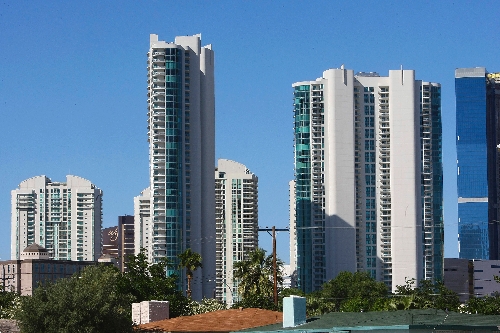Problems continue in high-rise condo market
It really didn't take a $40,000 study from the Sierra Club to determine that Las Vegas was overbuilt, putting a strain on natural resources. Just look at the vacant buildings.
Nowhere is it more apparent than in the high-rise condominium market where 5,527 completed units are sitting empty, waiting to be sold, housing analyst Larry Murphy said Friday at a meeting of the Las Vegas High-Rise and Condominium Association.
With an average of 22 high-rise closings a month, Las Vegas has a 250-month supply of inventory, or about 21 years, the president of SalesTraq research firm said. In comparison, the supply for traditional homes on the market here is between two and three months.
"I'm not passing judgment of what's good and what's bad. I'm just saying we have a 21-year supply," Murphy told about 100 real estate professionals at Cili's restaurant.
That's without projects that did not get built. At the height of the condo craze, there were about 120 high-rise buildings on the drawing boards in Las Vegas, he said. Among the higher-profile developments that fizzled were Las Ramblas, Ivana, Aqua Blue, Icon, Majestic and Wall Street Towers.
Murphy reported 838 high-rise resale units on the Multiple Listing Service, including 357 short sales and 73 real estate-owned, or bank-owned, units. The median price is $259 a square foot.
Many high-rise condos are having trouble closing escrow, Murphy said. Trump International wrote 1,262 sales contracts in a year, though fewer than 300 units have closed since March 2008.
It looks as if CityCenter is having the same problem, Murphy said. Only 78 units have closed escrow since the $8.4 billion megaresort opened on the Strip in December.
"If it follows the track of Trump, if that happens at CityCenter, they may be fortunate to close 25 percent of their units in the next three years," he said.
Las Vegas needs to rethink its vertical marketing, real estate consultant Steve Bottfeld of Marketing Solutions said. Retention is the key, he said, and Trump may have overlooked what it takes to keep buyers interested in the project.
"Was there e-mail communication with buyers during construction? Did they get invited to events? Were they offered financing? Were they made to feel important? No. They didn't retain buyers because none of that happened," Bottfeld said.
Everyone was buzzing about the "Manhattanization" of Las Vegas a few years ago, but Manhattan wasn't built overnight, he said. Verticality came in phases, starting with the first high-rise in 1888. Nothing was built during the 1901-1910 recession. The Chrysler Building didn't come until 1930.
"It goes in phases and we are in a negative cycle," Bottfeld said.
It takes two to three years to build a high-rise project, and it can't be done in phases like a new-home subdivision, Murphy said. All of the units have to be built at once. Most of the units are sold within the first three months of completion. After that, sales drop off dramatically.
Average prices have flattened out for traditional homes in Las Vegas, but are still declining for high-rises, he said. Units at Newport Lofts downtown are advertised for $115 a square foot.
"You can't build that for $115 a foot," Murphy said. "Anytime you can buy a property for less than it costs to construct, you know it's undervalued."
Las Vegas Mayor Oscar Goodman said he'd like to see better occupancy at downtown condo projects such as Juhl, Newport and SoHo Lofts, bringing grocery stores and boutique retail to ground-level space. He's heard several different plans for Streamline Tower, including making it a gaming hotel or condo-hotel.
"It's just sitting there. It's a heartbreaker, for sure" Goodman said. "I was hoping we'd have the critical mass for these condos by now, but it'll come. I am absolutely confident that when the world economy comes back, Las Vegas will flourish again."
Contact reporter Hubble Smith at hsmith@reviewjournal.com or 702-383-0491.






















